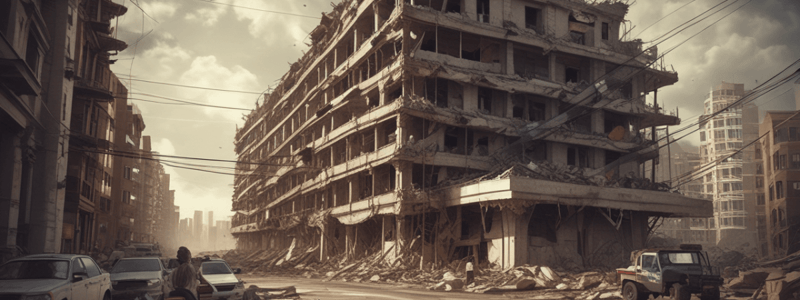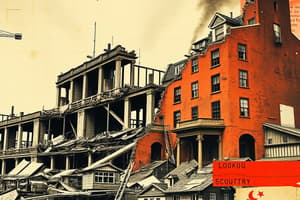Podcast
Questions and Answers
What is the primary responsibility of the Incident Commander regarding structural collapse?
What is the primary responsibility of the Incident Commander regarding structural collapse?
- To establish the exclusion zone only
- To gather information about the potential for a collapse (correct)
- To communicate with the media about the situation
- To ensure that all firefighters remain active in fighting the fire
What is the definition of a collapse zone?
What is the definition of a collapse zone?
- A designated area for equipment storage outside the fire scene
- An area that could contain debris if a building collapses, at least 1 ½ times the building height (correct)
- An area where firefighters cannot operate under any circumstances
- A safe zone for civilians during an active firefighting operation
What must all personnel on-scene do concerning the established collapse zone?
What must all personnel on-scene do concerning the established collapse zone?
- Ignore the collapse zone if they feel it is unnecessary
- Only report to the Incident Commander when they feel it is needed
- Establish their own individual zones based on personal judgment
- Adhere to the zones that have been established (correct)
When establishing an exclusion zone, what should be considered if the incident has gone defensive?
When establishing an exclusion zone, what should be considered if the incident has gone defensive?
What type of information should the Incident Commander gather to assess possible structural collapse?
What type of information should the Incident Commander gather to assess possible structural collapse?
What is a critical action companies should take concerning buildings in disrepair?
What is a critical action companies should take concerning buildings in disrepair?
Who has the responsibility to enforce the established collapse zones?
Who has the responsibility to enforce the established collapse zones?
What is the minimum distance for a collapse zone around a building?
What is the minimum distance for a collapse zone around a building?
What is the first action the Incident Commander (IC) should take upon arrival at a structure?
What is the first action the Incident Commander (IC) should take upon arrival at a structure?
What should the IC include when asking for Emergency Traffic tones to be transmitted?
What should the IC include when asking for Emergency Traffic tones to be transmitted?
How should an exclusion zone be marked?
How should an exclusion zone be marked?
What is the minimum distance for a collapse zone in relation to the building's height?
What is the minimum distance for a collapse zone in relation to the building's height?
What does the IC need to ensure when declaring a change in strategy from offensive to defensive?
What does the IC need to ensure when declaring a change in strategy from offensive to defensive?
When will the collapse zone be enforced until?
When will the collapse zone be enforced until?
Who may be assigned to monitor and enforce the exclusion zone?
Who may be assigned to monitor and enforce the exclusion zone?
Which feature does the IC need to be particularly cautious about during the initial assessment?
Which feature does the IC need to be particularly cautious about during the initial assessment?
Flashcards are hidden until you start studying
Study Notes
Incident Command and Structural Collapse Guidelines
- The guidelines aim to outline procedures for identifying, developing, and enforcing collapse zones during incidents with potential structural collapse.
- Responsibilities for monitoring structural integrity and safety fall primarily on the Incident Commander (IC) and all on-scene personnel.
Responsibilities of the Incident Commander (IC)
- Gather information on potential collapse risks from the building's condition, construction type, level of involvement, and reports from crew leaders.
- Continuously monitor the building from all sides for signs of instability.
- Enforce the established collapse zone and ensure compliance among all personnel on site.
Definitions of Zones
- Collapse Zone: Area surrounding a structure to contain debris in case of collapse, minimum of 1.5 times the building height.
- Exclusion Zone: Specific area designated by the IC to prohibit activities to protect personnel; expanded during defensive operations.
Procedures for Establishing Zones
- Companies should document and communicate the condition of buildings in disrepair to ensure safety awareness.
- Upon arrival, the IC or designated safety officer should conduct a complete 360-degree evaluation of the structure, identifying unstable areas and potential hazards.
- Should concerns arise, the IC must request Emergency Traffic tones from dispatch to communicate the exclusion zone's details to all necessary parties.
- Exclusion zones must be marked with Fire Line Tape after establishment and communication.
- If a collapse is deemed possible, the IC should establish a collapse zone and consider debris travel distance in determining its size.
- When shifting from offensive to defensive strategy, a Personal Accountability Report (PAR) should be issued to confirm all personnel's evacuation, adjusting the collapse zone accordingly.
- The established collapse zone remains enforced until the IC decides to alter it or the incident is resolved and transferred to another authority.
Importance of Communication
- Clear communication of zones and hazards is vital for ensuring the safety of all personnel involved during an incident and protecting the public from potential dangers associated with structural collapses.
Studying That Suits You
Use AI to generate personalized quizzes and flashcards to suit your learning preferences.




